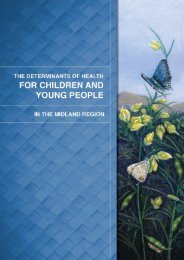Project SPLICE - Taranaki District Health Board
Project SPLICE - Taranaki District Health Board
Project SPLICE - Taranaki District Health Board
Create successful ePaper yourself
Turn your PDF publications into a flip-book with our unique Google optimized e-Paper software.
<strong>Project</strong> <strong>SPLICE</strong> FINAL - February 2010<br />
improve service provision. Interviews were analysed to identify key drivers and enablers for<br />
change and findings were integrated with available evidence. This report outlines the key<br />
drivers and enablers for change as well as the proposed model of care.<br />
1.2.1 Mäori engagement and consultation<br />
Specific attention has been paid to engagement with Mäori. Dr Sheridan is of Ngapuhi<br />
descent and because of her existing networks and experience in working with Māori primary<br />
health care provider organisations, particularly those providing nursing services, was<br />
responsible for consultation with <strong>Taranaki</strong> Māori health provider organisations. Other<br />
members of the team, Associate Professor Matthew Parsons and John Baird have strong<br />
records of prior relationships with Māori health providers and consumers. Both have<br />
worked on a number of DHB projects involving Māori such as the ‘Tairawhiti Services for<br />
Older Person <strong>Project</strong>’ and have established links with Māori research organisations, such as<br />
The James Henare Research Centre, The University of Auckland.<br />
Six Māori primary health care provider organisations were visited during 21 and 22 October<br />
2009 and kanohi ki te kanohi (face-to-face) interviews of up to 120 minutes were conducted<br />
by Dr Sheridan. The main purpose was to find out from providers about the Māori<br />
populations they served and their experiences of service provision. Specifically, we were<br />
interested in what worked well, why and the degree of sustainability. Also what was less<br />
successful, why, and whether any action had been taken or needed to be taken to address<br />
this. These conversations indicated a high interest in integrated service provision and a<br />
readiness to contribute to future health care frameworks for implementation to ensure<br />
cultural relevance and safety for Māori. The individuals and organisations visited are<br />
included in Appendix III.<br />
1.3 <strong>Project</strong> objectives<br />
The government has indicated that <strong>Taranaki</strong> DHB is expected to provide better, sooner more<br />
convenient health care for the population of <strong>Taranaki</strong>. This project seeks to provide the<br />
evidence to implement innovative and affordable models of service delivery to people with<br />
long term conditions and for older people. The expectation is that this report will provide<br />
recommendations on where these health services are best situated, to enable improved<br />
client focussed models of care aimed at better health outcomes for people.<br />
This new model of service delivery is expected to reduce avoidable hospital and residential<br />
care admissions by providing a supported and integrated health service to older people and<br />
those people with long term conditions living in the community. Further it will reduce the<br />
dependence of those living with long term disability and long term conditions, ensuring<br />
interventions and services can deliver effective holistic outcomes.<br />
More specifically, <strong>Project</strong> <strong>SPLICE</strong> 4 sought to:<br />
1. Explore the current health services in the community provided to older people and<br />
people living with long term conditions;<br />
2. Recommend evidence based and sustainable models of service delivery to provide this<br />
identified population with health services which enable them to have the best possible<br />
quality of life while living in the community;<br />
4<br />
Splice is defined by The Oxford English Dictionary as “join (a rope or ropes) by interweaving the strands at the ends.”<br />
10 | P a g e

















